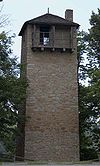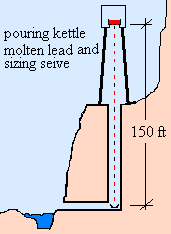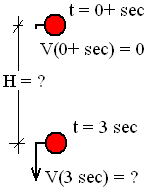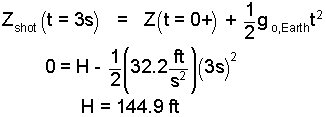| THERMO Spoken Here! ~ J. Pohl © | TOC NEXT ~ 52 |
Virginia Shot Tower

From years before the Revolutionary War and through the Civil War over a million spherical lead shot for muskets were manufactured at the shot tower in Wytheville, Virginia. The shot sold in twenty-five pound bags. Of the lead shot produced, 10% failed to qualify and were remelted.
What least mass of lead was melted per bag of shot produced?
♦ The system is an initial, unknown mass of lead in the solid state (1). That lead is melted, and poured through a sieve, to fall the height of the tower into water. The lead in state (2) is shot which is identified as acceptable or defective. About ten percent by mass must be remelted.
The mass equation in increment form is:

| (1) Mass is conserved. Some lead becomes serviceable shot, the remainder is melted again. |
The final mass (2) and initial masses (1) are written, then entered into the mass equation:

| (2) 2 |
The mass of usable shot produced is 25 pounds and ten percent of the initial melt of lead must be remelted.

| (3) |
Thus 27.8 pounds of lead were melted and dropped to produce 25 pounds of usable shot.
Shot Count: Approximately how many shot would a bag contain?
♦ The mass of functional shot equals their number times the mass of each.

| (4) Mass equals density times volume. |
The density of lead is 11.3 g/(cm)3 and the spherical shot had diameters of about 1.2 centimeters.

| (5) 5 |
This number (as every number calculated) is approximate. We cannot determine the precise count because the shot diameters will vary slightly around 1.2 centimeters.
 Three-Second Tower Engineers who built the first shot towers (~1740) came to agree that three seconds was the optimum time for the lead to fall. Longer times of fall required taller, more expensive towers. For falls quicker than three seconds, too many of the shot produced were out-of-round.
Three-Second Tower Engineers who built the first shot towers (~1740) came to agree that three seconds was the optimum time for the lead to fall. Longer times of fall required taller, more expensive towers. For falls quicker than three seconds, too many of the shot produced were out-of-round.
Calculate the speed attained by a shot that falls for three seconds.
♦ With motion of a body it is convenient to draw a sketch. One lead shot is shown in its initial and final states. It is dropped from a height, H. The shot starts to fall with zero initial velocity, accelerates downward with greater and greater speed due to the force of gravity. Friction of its movement through air impedes its fall. For now we ignore friction - the speed we calculate will be greater than actually would occur.
Although high school physics has provided equations to determine these answers, rarely do those courses show the source of the equations and how they are obtained. Below we show the source of those solutions using Newton's Momentum Equation applied to a body:

| (6) Differential equation and initial conditions for the fall of a shot. |
Expression (i) is the momentum equation with only the force of gravity acting. Momentum of the shot has only vertical components; VZ(t) is the vertical velocity as a function of time. Expressions (ii) and (iii) are called "initial conditions" which state that the initial (t = 0+) height is H and the initial vertical velocity equals zero, respectively. Conditions are required to solve the differential equation. Note (iv) denotes the time domain of the event which occurs in the time span 0+ ≤ t ≤ 3 seconds. Finally (v) identifies the quantities to be determined, the speed when the shot is at ground level and the height of the fall. We will bypass the complete solution of the differential equation for now.
To obtain numbers We use a familiar equation from physics which provides the velocity as:


| (7) |
A second equation from physics can be applied to determine the required height of the tower.

| (8) |
Motion of a body forced only by gravity (free fall), has been thoroughly studied and about which physics texts generally present a page of formulas. Those equations are adequate for a simple understanding of motion. More complicated situations of motion (and solution of other property equations) require integration of the property equation. To teach this fact and the techniques of solution is the purpose of this writing.
It makes sense to call Newton's Second Law a momentum equation. To account for the myriad of ways momentum of a body can change (or be changed) the momentum equation contains Newton's construct, force. Force is not a property; it is a mechanism of momentum change (or as some say, momentum transfer). The property mass has no construct; there being no mechanisms of creation or destruction of mass. Our next property equation, the energy equation, has two constructs which are work and heat.
Virginia Shot Tower

From years before the Revolutionary War and through the Civil War over a million spherical lead shot for muskets were manufactured at the shot tower in Wytheville, Virginia. The shot sold in twenty-five pound bags. Of the lead shot produced, 10% failed to qualify and were remelted.
What least mass of lead was melted per bag of shot produced?
Approximately how many shot would a bag contain?
Calculate the speed attained by a shot that falls for three seconds.
Premise presently unwritted!